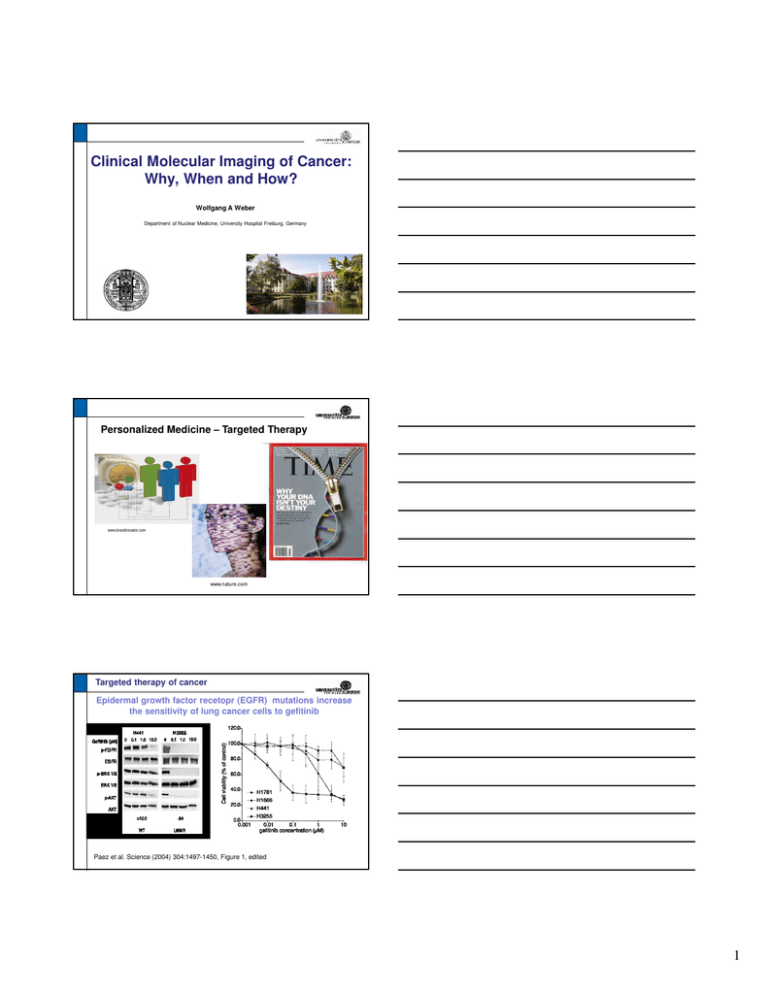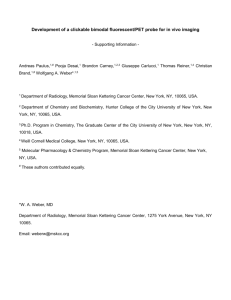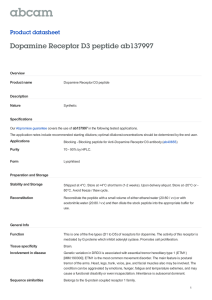Clinical Molecular Imaging of Cancer: Why, When and How?
advertisement

Clinical Molecular Imaging of Cancer: Why, When and How? Wolfgang A Weber Department of Nuclear Medicine, University Hospital Freiburg, Germany Personalized Medicine – Targeted Therapy www.brandinovator.com www.nature.com Targeted therapy of cancer Epidermal growth factor recetopr (EGFR) mutations increase the sensitivity of lung cancer cells to gefitinib Paez et al. Science (2004) 304:1497-1450, Figure 1, edited 1 Treatment of lung cancer patients with the EGFR kinase inhibitor gefitinib Mok et al. N Engl J Med (2009) 361:947-957, Figure 2 edited Gefitinib can be radiolabeled with fluorine-18 without changing its chemical properties F Gefitinib Cl HN O N O M eO N N 18F [18F]Gefitinib Cl HN O N O M eO N N Seimbille et al. J Labelled Compd Radiopharm. 2005;48:819–27 Su et al. Eur J Nucl Med Mol Imaging, 2008 ;35:1089-1099. Distribution of [18F]gefitinib in tumor bearing mice Su et al. Eur J Nucl Med Mol Imaging, 2008 ;35:1089-1099. Figure 5, Table 2 2 11C-Erlotinib PET SUV ∼1.0 Del(E746-A750) 11C: T12 = 1200 s Memon et al. (2009) Cancer Res 69:873-878, Figures 3 and 4, edited The hallmarks of cancer Hanahan and Weinberg Cell, 2011 Oncogenes and Glucose Metabolism IDH1 Yan N Engl J Med (2009), Zhao et al. Science (2009) Kroemer & Pouyssegur. Cancer Cell 13:472-482 (2008) Figure 2 (edited) 3 Effect of EGFR kinase inhibition on tumor FDG-uptake Baseline 2 x 1 mg Gefitinib H3255 Geftinib sensitive (L758R Mutation) Whole cell treated VC Myokard Cytosol fraction treated VC Plasma membrane fraction treated VC GLUT3 Na,K-ATPase A549 Gefitinib resistant Ras Mutation Actin Su et al. Clin Cancer Res, 12:5659-5665, 2006 Monitoring tumor response with FDG-PET Early response on FDG-PET and Survival in patients with non-small cell lung cancer Mileshkin et al. (2011) 17:3304-15, figure 2B Zander et al. J Clin Oncol (2011) 29:1701-8, figure 2A Role FDG-PET in treatment monitoring Other Signaling Pathways Secondary Mutations Change Treatment Genetically defined sensitivity (EGFR mutations amplification) no Outcome in an individual patient PET response ? Trial of Erlotinib, Gefitinib (+/-“X“) Ligand expression yes Continue Treatment Combination therapy Drug eflux 4 Tumor Size on PET and CT Weber et al. Nature Clin Pract Oncol (2008) 5:160-170, Figure 3 PET-Plan Study Optimization of radiotherapy planning of patients with inoperable locally advanced nonsmall-cell lung cancer with F-18-FDG Prospective randomized multicenter therapy optimizing trial 21 Centers, 396 Patients, start: Nov. 2009 ●● ●● ● ● ●● ●● ● ● ● ●● ● ● ● ●● ● ●● ● ● ● Arm A Arm B • Arm A: CT based target volume delineation • Arm B: PET based target volume delineation • Dose escalation study. • Dose limitation: tolerance of normal tissue End point: Local tumor control Ursula Nestle, Freiburg, Deutsche Krebshilfe New Targets for PET *CPCR4 CXCR4 Wester Clin Cancer Res (2007) 13:3470-3481, Figure 2, edited 5 Why peptides as radiopharmaceuticals? Peptide hormone receptors are excellent targets • Expression on the cell surface • Peptide hormones bind to these receptors with high affinity and specificity -> the receptors have a characteristic structure that can be recognized by an imaging agent • Peptide hormones can serve as starting points for tracer development Why peptides as radiopharmaceuticals? Peptides labeled with radiometals can be used for diagnostic and therapeutic purposes. Nuclear Medicine is more than Molecular Imaging Seidlin, Marinelli, Oshry. JAMA 1946 „This paper is a report of successful therapy of a case of metastatic adenocarcinoma of the thyroid treated by the principle of specific internal radiation with radioactive iodine.“ 6 Somatostatin receptors as a target for imaging and therapy Metastatic NET before Therapy Metastatic neuroendocrine tumor After three cycles 177Lu-DOTA-TATE Radionuclide therapy with 90Y-DOTA-TOC N= 1109 Response rate: 34% Imhof et al. J Clin Oncol (2011) 29:2416-2423, Figures 2 and 3 7 Voxel based based dosimetry for calculation of tumor dose 177Lu-DOTATATE therapy Gy/GBq Average dose 5.1 Gy/GBq = 76 Gy/30 GBq Scheler, Fischer, Wild 2011 The bombesin receptor family Bombesin: 14 aa, found in toad bombina bombina Glp-Gln-Arg-Leu-Gly-Asn-Gln-Trp-Ala-Val-Gly-His-Leu-Met-NH2 GRP: Gastrin relasing peptide 27 aa, human counterpart -…-…-…-…-Arg-Gly-Asn-His-Trp-Ala-Val-Gly-His-Leu-Met-NH2 Bombesin receptors Bombina bombina • BB1 receptor (neuromedin B receptor) • BB2 receptor (gastrin-releasing peptide receptor) • BB3 receptor (orphan bombesin receptor) • BB4 receptor (only amphibians) GRP receptor expression in human prostate cancer Histology Autoradiography GRP receptors are expressed in PIN (prostate intraepithelial neoplasia) and prostate cancer, but not in normal prostate or hyperplasia (n=36) Markwalder & Reubi. Cancer Res (1999) 59:1152-1159 8 The bombesin receptor family Bombesin based radioagonists were studied in preclinical models and patients Problems encountered • Limited metabolic stability • High uptake in the gastrointestinal tract • Side effects like nausea, vomiting, cramps in clinical studies • Potential mitogenic effects Bombesin Antagonists as an Alternative? • Promising preclinical and clinical results with somatostatin antagonists • Bombesin antagonists are being developed for anticancer therapies • Less/no side effects of bombesin antagonists expected GRP receptor antagonist CBC-AR-06 CBC (stable chelator for 64Cu) • Statin-based bombesin antagonist (PEG4) (active group) 64Cu half-life 12.7 h • Spacer PET imaging for several hours to allow for urinary clerance of the peptide IC50 CBC-AR-06 = 5.5 ± 1.3 nmol/L (assessed by in-vitro GRP receptor autoradiography using 125I-Tyr4-Bombesin) Results small animal PET/CT 16.7% IA/g 1 h p.i. 12.0% IA/g 16.7% IA/g 4 h p.i. 1.5% IA/g 12.0% IA/g blocking 1000 HU 1 h p.i. 6.8% IA/g ~60% blocked 22 h p.i. 1.5% IA/g 12.0% IA/g blocking 22 h p.i. -900 HU 0.5% IA/g ~70% blocked 9 Imaging of bombesin receptors in prostate cancer Bombesin receptor autoradiography ex vivo 64Cu-CBC-AR-06-PET/CT 4 h p.i. Bombesine and Choline PET/CT in a patient with PSA recurrence 0 SUV 5 Choline PET/CT 0 SUV 6 Bombesine PET/CT Combination therapy with the bombesin receptor antagonist 177Lu-RM2 and rapamycin Nude mice bearing PC3 xenografts Dumont, Mansi, et al. WMIC 2011 10 PET imaging in oncology • • • • Research Proliferation Hypoxia Apoptosis Rezeptors (Integrins, Bombesin, CXCR4, Folate) • Metabolism (Glucose, amino acids, lipids, …) § § § § § § § § § € € € € € € € € € Regulatory approval • Glucose metabolism (FDG) • Described 1980, approved 2000, reimbursed (in Germany) ???? They all fly, but do they need the same regulations? Airbus 380-800 Hang glider http://www.asiatraveltips.com Toy plane http://www.ballonservice.de http://www.graupner.de Where to invest? 210.000 NSCLC/year in in the US ~ 40,000 resections w/o PET: ~17000 not curative w PET: ~8000 not curative No reported side efffects of PET Radiopharmceuticals in 81.801 applications Silberstein et al. J Nucl Med (1998) *extrapolation of the data of the PLUS study (van Tinteren 2002) 11 Can biologists/physicians fix a radio? Y Lazebnik. Cancer Cell (2002) 2:179-182, Figures 1 and 2 Systems Biology and Molecular Imaging Y Lazebnik. Cancer Cell (2002) 2:179-182, Figure 3 12





